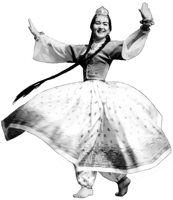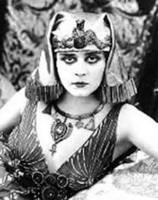
|
The Society of Folk Dance Historians (SFDH)
Oriental Dance
[
Home |
About |
Encyclopedia | CLICK AN IMAGE TO ENLARGE |

|
Oriental Dance is sometimes called "dance of the harems" and "danse du ventre."
The image of Oriental dancing as a sensational exhibition has long been firmly established in the American imagination. At the beginning of the 19th century, Stephen Decatur led United States marines in a foray against Yusef Karanamli, the Basha of Tripoli, in an attempt to replace him with his brother, who had taken refuge in Egypt. Despite successes against the Algerines, the attempt to depose Yusef was a failure, and he continued to reign for many years. But the memories of the Barbary Coast and its seductions were not soon forgotten by the American adventurers who returned from "the shores of Tripoli."
In 1851, George Curtis, an American journalist who happened to be visiting in Egypt, saw the celebrated Safiya. Safiya was one of the Ghawazee, that traditional caste of public dancers for whom Egypt has long been famed, and Curtis exploited the opportunity to thrill readers of the New York Tribune with a florid account of her performance.
By 1983, when the last sky-rockets glimmered out above the closing Chicago Fair, little remained but memories until the legend "Little Egypt" began. This mythical creature in her naughty nineties costume was not among the many Oriental dancers who performed at the Algerian Village and other Middle Eastern exhibits. Those dancers all wore their own national adaptations of the prevailing Ottoman dress of the period, and consequently resembled ladies from Bosnia or Albania much more closely than they did Mata Hari. Nonetheless, the crowds that thronged the Fair's midway were prepared to be as pleasantly shocked as if they were Oriental gentlemen eyeing well-filled tights at the Paris Opera.
After the turn of the century, two distinctly different imitations of the Oriental dance appeared. One, which attempted to capitalize on the sensational elements in the dance, was presented at Coney Island and similar resorts, eventually becoming that great American institution, the strip-tease. The other interpretation apparently materialized during a Turkish-coffee break in a WYCA gymnasium. This latter sort of travesty has been more or less continuously on view in uncounted films and a half-century of "Kismet" productions.

 The "shimmy" of the twenties captured some of the spontaneity of Egyptian village (beledy) dancing and even the gaiety of Ghawazee dancing. The straight, unfitted dresses, embroidered with flattened silver wire, became a fashion for a while, but the dominant mood was set by the dilated nostrils of Valentino and Theda Bara (Arab spelled backward, of course). Even if she didn't dance (and she usually didn't), the Vamp, dripping ropes of pearls over her beaded essentials, was easily identified as that symbol of Sex and Sin, La Danseuse Egyptienne. But by the time the last roars of the twenties had died away, so had the shimmy, the Vamp, and the Sheik.
The "shimmy" of the twenties captured some of the spontaneity of Egyptian village (beledy) dancing and even the gaiety of Ghawazee dancing. The straight, unfitted dresses, embroidered with flattened silver wire, became a fashion for a while, but the dominant mood was set by the dilated nostrils of Valentino and Theda Bara (Arab spelled backward, of course). Even if she didn't dance (and she usually didn't), the Vamp, dripping ropes of pearls over her beaded essentials, was easily identified as that symbol of Sex and Sin, La Danseuse Egyptienne. But by the time the last roars of the twenties had died away, so had the shimmy, the Vamp, and the Sheik.
I should like to forget about the fantastic parodies of Oriental dancing with which occasional films of the thirties and forties were ornamented but, unfortunately, they are still around late at night. Then along came Samia Gamal, "King Farouk's favourite" as she was billed. Samia made headlines by marrying a wealthy Texan, Sheppard King. "Not one of the Shepherd Kings?" cried the comics of the time. Samia appeared in a film, "Valley of the Kings," which has the distinction of being the first American motion picture to include genuine Egyptian folk music and dance.
Miss Gamal's nightclub stint was something less than a triumph, however. If she had performed to the accompaniment of Arab musicians instead of the hopeless attempts of an American dance band, she might have started the immense vogue for Arabic popular music and dance that began just a few years later with the Broadway production of "Fanny." The tremendous success of this offering was due in no small part to the dancing of Nejla Ates, a Turkish dancer, and the singing and oud playing of Egyptian pop-star Mohammed El-Bakkar. Just by playing to continuously packed houses, "Fanny" created the first mass-audience for Arabic popular music and dance in this country. Since that time, Middle Eastern nightclubs have continued to open in almost every large city in the United States.
In Egyptian tombs dating from the early 18th dynasty, dancers are depicted in postures and using gestures commonly employed in Egyptian dancing today. Musicians play the double pipe (zumarrah) and others clap their hands rhythmically. The scene is so vivid that if one is familiar with present-day Egyptian folk music, it is almost possible to hear the sounds represented. The zone (girdle) and bangles worn by the dancers are similar to those worn by dancers represented at various more recent sites in India.
The Persian conquest of Egypt caused an influx of Eastern influence that was to be repeated several times, most notably at the period of Ottoman domination. Egyptian dancing had already spread to Carthage and hence to Iberia through the offices of the Phoenicians, and had become popular in Rome after the last Punic War, and in the Romanized Judea of Herod's day it would seem highly improbable that the Princess would have performed in any other style.
The Byzantine Empire, with its capital at Constantinople, continued to enjoy the dances and other entertainments of Rome. Theodora, a famous dancer noted for her backbends and other acrobatics, so captivated Justinian that he made her his Empress.
During the golden age of Arabic culture, first at Baghdad, and later at Cordoba, music and dance were cultivated along with poetry, architecture, and the sciences. It is probable that the descendants of the Gaditanae, the famous dances of Gades (Cadiz), continued to play their profession in this climate so favorable to the arts. Even today, the Gitana is among the first images evoked by the very mention of Spain.
In Egypt during the Ottoman period the chief danseuses were the Ghawazee, who resembled more closely the Gitanos of Spain than the Motreb of Persia or the various Turkish corporations of dancers and musicians; an endogamous group like the Ouled Nail of Algeria, they are sometimes called a tribe.
LA DANSE DU VENTRE
English writers and travelers of the 18th and 19th centuries have written many accounts of Oriental Dance, as they invariably call the dance of the Ghawazee, never calling it any other name than that used by the Orientals themselves. The term "harem dance" is not entirely inappropriate, and makes the important point that ladies enjoy dancing in the privacy of their homes, and not only as an exhibition by professional entertainers. It was a 19th century Frenchman who first coined the term "danse du ventre," and an American who translated it as "belly dance," which is much the same thing as calling ballet "toe dancing."
Even in Egypt today, Oriental dancing is never called "belly dancing" unless the performer is wearing the cabaret-style costume that was invented in the late 19th century by European "Bayaderes" who adapted the full skirt and choli (a midriff-baring blouse) of the Nautchnees. This costume was not introduced into Egypt until the present century, and even today has not been adopted by the remaining Ghawazee in Upper Egypt.
Oriental dancing has never been wanting in either admirers or detractors, and, as with any other kind of dance, the reaction of the viewer is probably fairly dependent upon the excellence (or lack of it) in the performer. Famous writers, including Arnold Bennett and Gustave Flaubert, have been profoundly affected by these dancers, and Sonia Ivanova, the most respected ballet teacher in Cairo, declared that Egyptian dancing can rival the dances of India and reach artistic equality with classic ballet.
Printed in Folk Dance Scene, September 1973.
This page © 2018 by Ron Houston.
Please do not copy any part of this page without including this copyright notice.
Please do not copy small portions out of context.
Please do not copy large portions without permission from Ron Houston.